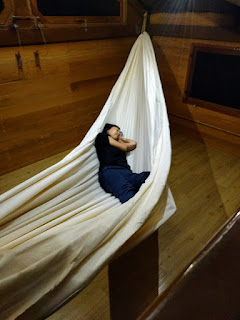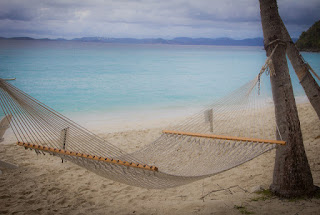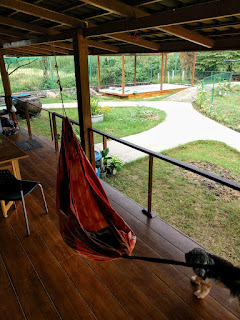 |
| This is the hammock we built. |
I’ve always seen a hammock as something to lounge on the balcony in and read a book on a nice summer day, but not something to spend the night in. On a lark, I decided to Google “is sleeping in a hammock bad for you?”, and came up with some interesting info. The most complete info I found on the subject is here.
The short version is, most of what people think of when they think of a hammock is not very good for you. But there are better hammocks. In particular, “spreader bars” make the hammock dangerously unstable, and the rope net pinches off the circulation in your skin. And the iconic image of a hammock has both spreader bars and a rope net construction like this:
 |
| https://www.flickr.com/photos/teegardin/6669052393/in/gallery-72955109@N06-72157629987777052/ |
But for serious hammock sleeping, most people seem to recommend something like a “Mayan hammock” like this:
 |
| https://en.wikipedia.org/wiki/Hammock#/media/File:Doublemayanhammock.jpg |
I’ve always found beds rather uncomfortable in every position, and since I threw out my back lifting sandbags in the Bangkok flooding of 2010, I’m always interested in learning more about alternatives that might be better for my back.
The key seems to be that without the spreader bars, the hammock naturally curls up on the sides and cradles you so you can’t easily fall out. With the spreader bars, you can easily imagine rolling towards the sides and being flipped onto the ground. (Look again at the picture of the net hammock with spreader bars above.)
The most interesting little tidbit of knowledge I found on the subject of sleeping in a hammock relates to the angle you sleep at. Basically, you don’t sleep with your feet towards one anchor point and your head towards another. This curves your spine unnecessarily. Instead, you rotate about 30 degrees off from that axis, and you’ll find that your body straightens out and your spine curve much much less. Again, the best explanation I’ve found is here.
So out of curiosity, I went full blown geek (Praew’s words) and tried to “tune” Praew’s napping and reading hammock on the balcony of BaanMae according to this useful hammock hang calculator page here.
Using the info on the hammock hang calculator, I realized that we had initially hung up the hammock at points way too close together and high. As a result, you really do end up with a much more curved spine than necessary. I ended up spreading the distance between the anchor points to be about 50% further apart (by lengthening the hanging rope and tying up to different points on the balcony roof) and voila! Much more comfortable hammock.
Then I tried out the “hammock angle”. Basically, you lie in the hammock with your head towards one anchor point and your feet towards the other, and then just scoot your feet left until it drops to a much lower height, and then scoot your head to the right until it drops to a much lower height. And sure enough, it became much more comfortable.
But not quite comfortable enough. Mostly, I chock that up to it being quite small for me. So I looked up the sizes of the larger hammocks, and decided I really wanted to try sleeping in a good sized hammock.
A look around suggests that no one makes the “Mayan style hammocks” in Thailand. (Not too surprising given the geographic origins of the Mayan people being on a different continent.) So, as usual, I decided we would build our own.
This post is getting a bit long and I have to get going to dinner, so I’ll post more on how we built it soon.
